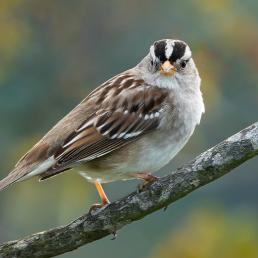

Join BirdNote tomorrow, November 30th!
Illustrator David Sibley and actor H. Jon Benjamin will face off in the bird illustration battle of the century during BirdNote's Year-end Celebration and Auction!
Bring the world of birds to your classroom
A lesson for first grade in twenty minutes or more
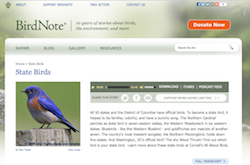 | 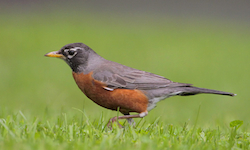 | 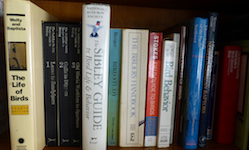 | ||
| Summary | Lesson Plan | Resources |
Summary
In Chambersburg, Pennsylvania, Janice McClintock uses this lesson to introduce her first-grade class to non-fiction reading. She uses photos, personal stories, and fun bird facts to bring the birds alive. Students read aloud together from a book about birds and later add bird drawings and facts to their journals.
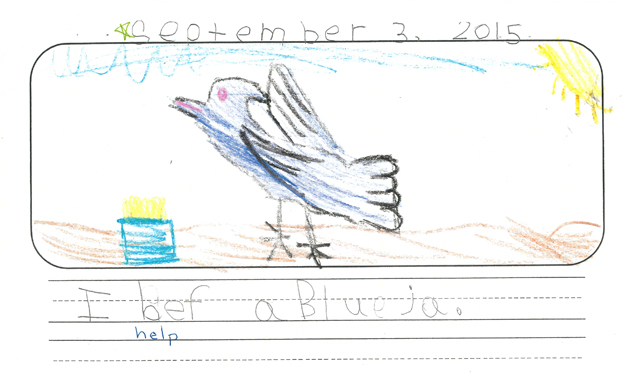
Title: Reading Aloud about Birds
Duration: Twenty minutes (or more)
Setting: Indoors
Subject Areas: English Language Arts
Grade Level: 1
Common Core Standards: CC.1.2
Lesson Objectives:
• Introduce non-fiction texts.
• Students will read, understand, and respond to informational text – with emphasis on comprehension, making connections among ideas and between texts, with focus on textual evidence.
How BirdNote is used: extension activity to learn more about birds introduced in the reading of the book
Materials: Bring On the Birds by Susan Stockdale, Peachtree Publishers, Atlanta, Georgia; BirdNote stories; pictures of birds on the BirdNote website or on the AllAboutBirds website
Extensions: creating a journal with bird drawings and facts; listening to BirdNote stories
Lesson Plan
1. Introduction: This book is a type of book called non-fiction. It is not a story like “Little Red Riding Hood." It is an informational text that tells about a topic and helps us learn new information about something that we might not have known before.
2. Before reading: Vocabulary in the text was familiar, however, the actual names of the different bird species provided at the end of the book were introduced and discussed. Show personal photographs of Blue Jays that eat peanuts on my deck each day. Then show photos of our favorite Red-Winged Blackbird and the story of how this bird appears every time a special little boy named Jay comes to visit me. This book is all about birds. There are many different kinds of birds, but see if you can hear at least one thing that they all have in common.
3. Read out loud with the whole class participating.
Comprehension check during reading:
Page 12: Pause and ask if students have ever seen a hummingbird.
“Hummingbirds beat their wings up to 38 times per second!”
Ask students to try to “flap” their arms 38 times in a second. Have stop-watch handy.
Page 22: The Ostrich is the world’s tallest and heaviest bird. It cannot fly. How do you think it gets away from other animals that might want to eat it? Turn and talk with your partner to decide how it might get away.
4. After reading:
Show the pictures of each bird again, page by page, and tell students each bird’s name. Include interesting facts:
Whooping Crane (makes a loud sound that sounds like a whoop)
Blue-footed Booby (lifts feet up and down doing a little dance)
White-tailed Ptarmigan (changes colors with the seasons to stay camouflaged)
Ruffled Grouse (Pennsylvania's state bird)
Red-billed Oxpecker (rides on large animals, eating bugs off their hides) Oxpeckers also alert the animal to danger by hissing, when another animal tries to sneak up on it.
Read page 26 again. What is one thing that all birds have in common? (feathers, come from eggs)
5. Follow-up:
Encourage students to draw a picture of their favorite bird and write one interesting fact about the bird in their writing journals.
Have the students listen to a BirdNote story about one of the birds they have just read about.
Resources
Bring On the Birds Written and illustrated by Susan Stockdale. –1st ed. p.cm., Peachtree Publishers, Atlanta, Georgia.
BirdNote stories – many are possible but here are suggestions:
Meet the Blue Jay
Northern Cardinal - Meet the Cardinal
Red-winged Blackbird Harem
Ruffed Grouse: Splendid Drummer (the PA state bird!)
Ruby-throated Hummingbird
Hummingbirds are Mighty Puffballs
Consider the Ostrich
AllAboutBirds website - for photos of birds
Do you have a lesson plan to share? Check out the guidelines, then download the submission form. Thank you!
<< Back to Educators Who Use BirdNote
